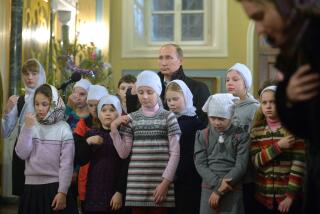Soviet Women Far From Emancipated
- Share via
MOSCOW — The lives of Soviet women are marked by wholesale abortions, soaring divorce rates, a rising number of illegitimate children and continuing male dominance in marriage and family life, a leading demographer says.
The emancipation of women is “far from complete” in the Soviet Union, despite a proclamation of the equality of the sexes after the Bolshevik Revolution in 1917, Viktor Perevadentsev wrote in the current issue of the popular magazine, Smena.
Soviet women, however, have made significant strides in becoming better educated, and they now comprise the bulk of the country’s intelligentsia and are leading supporters of the arts, the article said.
Their increasing sophistication also has led women to be more demanding in selecting a husband or male companion, and their independence has aroused resentment in men, according to Perevadentsev, who is also an economist.
Responding to a flood of letters to the magazine inquiring about the status of men and women, Perevadentsev’s article is one of the most candid discussions of the sensitive topic of family relations in a Soviet general-circulation magazine. It reflects Soviet leader Mikhail S. Gorbachev’s stress on the need for openness on controversial topics.
There were nearly 1 million divorces in the Soviet Union last year, or one for every three marriages, Perevadentsev wrote. That is a three-fold increase since 1960.
“Highest of all are the divorce figures in the big cities,” the article said. “In Moscow there were 515 divorces registered for every 1,000 marriages.”
Even more shocking, the demographer said, are birth and abortion statistics from Perm, a city in Siberia with more than 1 million population.
“For every 1,000 women pregnant for the first time, there were 272 abortions, 140 births outside of marriage, 271 births in the first month of marriage and 317 births of children conceived after marriage,” he wrote.
Premarital Sex Rising
“These figures prove conclusively that almost all young women in the big cities have sex before marriage. In the past, examples of premarital sex among young women were rare exceptions and strictly censured. In Russian villages, the gates of the parents’ homes were covered with tar in such cases.”
Nineteen percent of mothers’ first children are born out of wedlock, Perevadentsev said, and many unmarried women with children are in their teens and rarely get public sympathy, while older, single women who have children win widespread approval.
When marriages break up, he wrote, nearly all children remain with the mothers. Because divorced women rarely remarry, their children become what the article called “semi-orphans” without a male parent, and there are about a million more of these children each year.
The article attributed the breakup of marriages and families primarily to heavy drinking by the men.
In a Kiev study, the husband’s drinking was named as the main reason for half of the divorce suits filed by women, Perevadentsev said, and was cited as an aggravating factor in most of the others.
“The greatest remnants of actual inequality are preserved both in the family and in the spheres of love, marriage and family as a whole, where progress toward equality is slow and difficult,” the demographer wrote. “And it is above all the privileged male and the elderly who are resisting these changes.”
The Soviet Union is unique, he said, in the growing preponderance of women in the intelligentsia, with higher levels of education and cultural outlook than men.
“Out of every 10 workers engaged in intellectual labor, six are women,” he noted.
“There is massive dissatisfaction among women with . . . their partners’ ‘grayness’ and immaturity,” the social scientist concluded. “Overcoming the backwardness of male culture is one of the principal conditions of . . . future harmony.”
More to Read
Sign up for Essential California
The most important California stories and recommendations in your inbox every morning.
You may occasionally receive promotional content from the Los Angeles Times.













